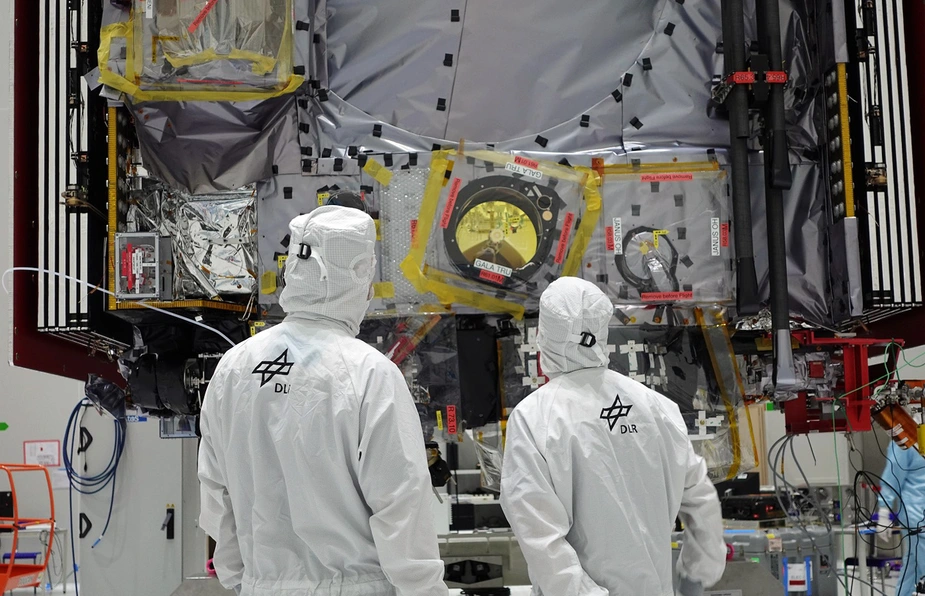DLR pools expertise in space research
The new DLR Institute of Space Research is being formed from the internationally acclaimed Institutes of Optical Sensor Systems and Planetary Research
Space is a key technology for the future, essential for exploring planets, Earth observation and security. Satellites and space probes equipped with highly specialised observation instruments are indispensable for all of these missions. To consolidate its expertise in space instrumentation and space research, the German Aerospace Center (Deutsches Zentrum für Luft- und Raumfahrt; DLR) established the Institute of Space Research in Berlin-Adlershof on 1 May 2025. The result is a globally leading centre of excellence for optical sensor systems, dedicated to understanding the diversity of planetary bodies, monitoring our planet and supporting security applications.
The new DLR Institute of Space Research is the result of a merger between the former DLR Institutes of Optical Sensor Systems and Planetary Research, both previously based at the Berlin-Adlershof technology park. "With the new Institute of Space Research, we want to build on our achievements and fully harness existing expertise to further strengthen and develop DLR's site in Berlin-Adlershof," explains Anke Kaysser-Pyzalla, Chair of the DLR Executive Board. "With approximately 300 employees, the institute covers the entire chain – from the initial research idea, through design, construction and verification of instruments, to their operational use and the processing, scientific evaluation and archiving of acquired data. This enables us to introduce new technologies through the exchange of knowledge with our colleagues in research, industry, business and public institutions."
"We see ourselves as a partner for universities, research institutions, industry, public authorities and policymakers, and we work closely with them," adds Heinz-Wilhelm Hübers, Director of the newly established institute. "We play a leading role in national and international space missions, helping to shape them. In doing so, we contribute to answering fundamental questions of our time and to tackling major societal challenges such as climate change and security." The institute supports the implementation of Germany's Space Strategy and contributes to the science and exploration programmes of the European Space Agency (ESA), NASA, the Japan Aerospace Exploration Agency (JAXA) and other space organisations.
In March 2024, the DLR Supervisory Board paved the way for merging the Berlin-based DLR Institutes for Optical Sensor Systems and Planetary Research. As of 1 May 2025, Heinz-Wilhelm Hübers has assumed responsibility for the resulting Institute of Space Research. Heike Rauer, former Director of the Institute of Planetary Research, will advise the DLR Executive Board on matters relating to ESA. Professor Rauer will also expand and strengthen cooperation with Freie Universität Berlin in the field of planetary geophysics.
Optical sensors, planetary research and Earth observation
At the Institute of Space Research, cameras, spectrometers, radiometers and laser altimeters are developed in close cooperation with industry, covering the entire spectral range – from ultraviolet, visible and infrared light through to terahertz radiation. Instruments developed by DLR are currently flying on more than 20 national and international space missions from ESA, NASA and other space agencies. Examples include ESA's planetary missions BepiColombo (to Mercury) and JUICE (to Jupiter), the PLATO space telescope (scheduled for launch at the end of 2026) and the environmental instruments DESIS (on the International Space Station ISS) and Germany's EnMAP mission to monitor Earth’s environment. Heike Rauer will continue to lead the ESA PLATO science consortium as Principal Investigator.
Highly specialised instruments on space probes are used to investigate the formation and evolution of planets, moons, asteroids and comets. The search for life-friendly conditions signalling 'habitable' environments – both within our Solar System and in extrasolar planetary systems – is becoming increasingly important. These diverse celestial bodies are being studied using sophisticated instruments both remotely and, where possible, from their surface. Numerical modelling is an important tool for understanding the evolution of these vastly different bodies, complimented by laboratory investigations of space samples and analogue geological formations on Earth.
The scientific instruments developed at the institute also provide insights into the state and development of Earth's ecosystems and atmosphere. As a result, they make an important contribution to understanding complex, interconnected environmental systems and global climate change. Through its research, the institute is helping to improve our understanding of Earth and how we can use its natural resources in a more sustainable and environmentally compatible way.
Instruments for civil protection and disaster relief
The institute also contributes its expertise in support of public authorities and organisations dedicated to civil protection. Its optical instruments are used in both security research and operational missions. The data obtained is processed at the institute and used for situational awareness. In this way, the institute is making important contributions to civil protection, disaster relief and crisis management.
Related links:
Contact:
Falk Dambowsky
Head of Media Relations, Editor
German Aerospace Center (DLR)
Linder Höhe, 51147 Köln
+49 2203 601-3959
Prof. Dr. Dr. h. c. Heinz-Wilhelm Hübers
Director
Institute of Space Research
Rutherfordstraße 2, 12489 Berlin
www.dlr.de/wr
Press release DLR, 5 May 2025
